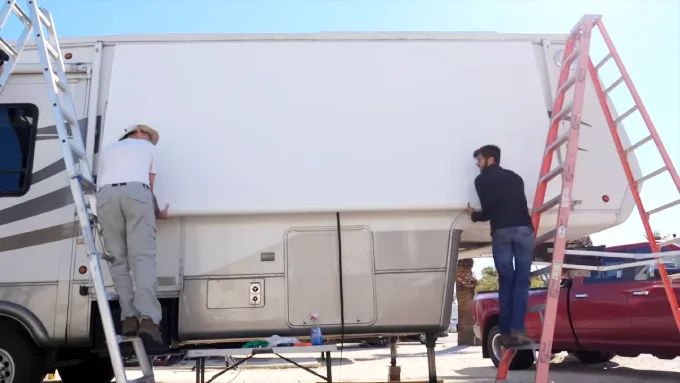Last Updated on April 20, 2023
As an RV owner, you know that a well-functioning awning is a crucial part of your outdoor living space. It provides shade and protection and adds value to your RV.
Your awning may become worn down or damaged due to normal wear and tear as time passes. That’s why you need to replace it. But, when considering replacing your RV awning, you might wonder how much it’ll cost.
Replacing your RV awning can be pricey, but the cost depends on what type of awning you get, how large it is, and if installation requires extra finesse.
On average, you can expect to spend between $200 and $4000, with most people paying around $1,500-$2,000 for a large patio awning.
Let’s explore the different aspects and costs associated with replacing your RV awning, so you can make an informed decision and get back to enjoying the great outdoors in style and comfort.
How Much Does It Cost to Replace RV Awning: What Factors Determine?
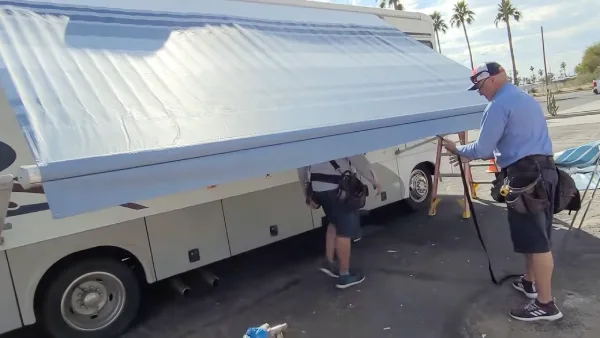
The cost to replace an RV awning can be influenced by several factors, including:
1. Type of Awning
The type of RV awning chosen significantly affects the replacement cost. Various types of awnings are available, such as manual retractable, motorized retractable, slide-out, and window awnings.
Manual retractable awnings are the most affordable but require manual effort to retract the awning.
On the other hand, motorized retractable awnings are more expensive but offer convenience with their automatic retracting mechanism.
Given their location, slide-out awnings are the most challenging to replace, which can result in more labor costs. Finally, window awnings are the easiest and cheapest to replace due to their smaller size.
2. Size of the Awning
The size of an awning is usually measured in length or width and directly impacts the cost of replacement. A bigger awning costs more to install in terms of materials and labor.
Replacing a longer or wider awning will require more fabric, support braces, and labor than a smaller one. Therefore, carefully considering the awning size is necessary when calculating the replacement cost.
3. Quality of the Awning
The quality of an RV awning can affect its price considerably. Higher quality translates to better materials, construction, and durability, costing more.
Cheaper or low-quality awnings may be more affordable, but they may not last as long and may require replacement sooner, resulting in higher long-term costs.
Choosing a reputable brand or manufacturer that offers warranties and good customer service may cost more upfront, but it is a worthwhile investment.
4. Awning Fabric Material
The type of fabric used for the awning can significantly impact the replacement cost. Awning fabrics come in different materials, such as vinyl, acrylic, and polyester, with varying costs and durability.
Vinyl is the cheapest option but is less durable and may crack or peel over time. Acrylic is more expensive than vinyl but is more durable and has better color fastness.
Polyester is the most expensive fabric option but is the most durable, resistant to mold and mildew, and easy to clean. Proper selection of the fabric material is crucial when considering the replacement cost.
5. Awning Features
Additional features in RV awnings can increase the replacement cost. Built-in LED lights, wind sensors, remote controls, and automatic retracting mechanisms are some of the common features that add to the awning cost.
Adding these features can offer convenience and ease of use, but careful consideration of the need and cost-effectiveness should be considered.
6. Labor Charges
The labor cost for the installation of the replacement awning can vary based on the complexity of the installation, local labor rates, and the installer’s expertise.
More complex installations, such as motorized awnings or awnings requiring modifications to the RV, may require higher labor charges. Considering the labor cost when calculating the total cost of replacing an RV awning is essential.
Types of RV Awnings Available for Replacing
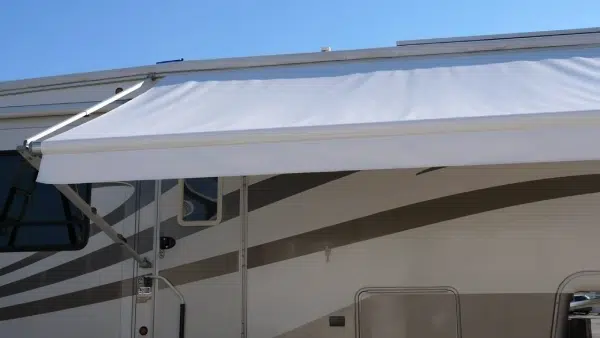
The most common type of RV awning is the patio awning. This type of awning is attached to the side of the RV and extends out over the patio area. Patio awnings come in various sizes and materials, including vinyl, acrylic, and polyester.
Another popular type of RV awning is the window awning. Window awnings are designed to provide shade for the windows of your RV. They can be made from various materials, including aluminum, vinyl, or fabric.
Slide-out awnings are also available for those who have slide-outs on their RVs. These awnings are designed to cover the slide-out when it is extended, providing additional shade and protection from the elements.
There are also roof-mounted RV awnings available. These types of awnings attach directly to your RV’s roof and can be extended out over either side.
In terms of operation, manual, automatic, and hybrid awnings are the most common types. Manual awnings are the most affordable type of RV awning. They are operated by hand and require no electricity to function. Manual awnings usually have a crank or a pull-out handle that you use to extend or retract the awning. They are easy to use but may take some time to set up.
Automatic awnings are more expensive than manual awnings but offer more convenience. You can extend or retract automatic awnings with a button or a remote. They also come with wind sensors that automatically retract the awning in case of strong winds.
Hybrid awnings combine the features of both manual and automatic awnings. Hybrid awnings have an electric motor for easy extension and retraction, but they also come with a manual override option in case of power failure.
When choosing an RV awning replacement, it is important to consider the type that best suits your needs and budget. Manual awnings may be suitable if you are on a tight budget, while automatic or hybrid options may be better if you want more convenience and ease of use.
It is worth noting that the type of RV you have may also influence your choice of an RV awning replacement. For example, a Class A motorhome may need a larger and sturdier awning than a smaller travel trailer.
DIY vs. Professional RV Awning Replacement: Which is Better?
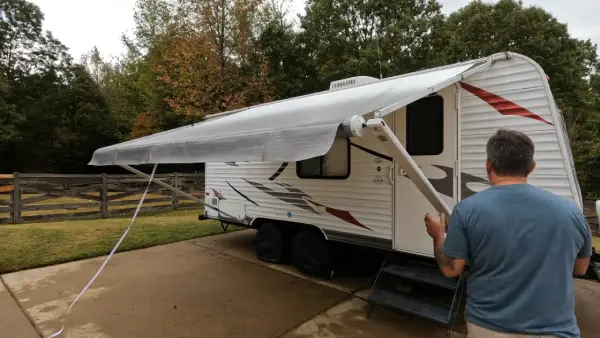
When replacing an RV awning, one of the first decisions you’ll need to make is whether to tackle the job yourself or hire a professional.
There are pros and cons to both options, so it’s important to consider your own experience level and comfort with DIY projects before making a decision.
One advantage of doing the replacement yourself is that you can save money on labor costs. But remember that replacing an RV awning can be a complex process that requires some technical skill and knowledge.
If you’re not confident in your abilities, attempting a DIY replacement could end up costing you more in the long run if you make mistakes or damage your RV.
In contrast, hiring a professional makes sure the job gets done right. Professional installers have the expertise and equipment needed to complete the replacement quickly and safely. They may also offer warranties on their workmanship and materials, giving you added peace of mind.
When deciding between DIY and professional replacement, consider factors such as your budget, timeline, and skill level.
If you’re comfortable with DIY projects and have some experience working with tools and mechanical systems, doing the replacement yourself could be a good option.
Hiring a professional might be worth the investment if you’re short on time or lack confidence in your abilities.
How to Save Money on RV Awning Replacement Costs?
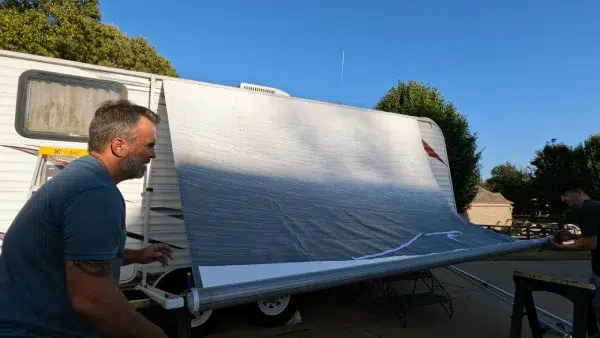
It can be expensive to replace an RV awning, but there are ways to save. Here are some tips on saving money on RV awning replacements:
Shopping Around for Deals and Discounts
Shopping around for deals and discounts is one of the best ways to reduce awning replacement costs.
There are a few different ways to find deals and discounts on RV awnings. One option is looking for sales or promotions from retailers specializing in RV parts and accessories.
These retailers may offer discounts on specific brands or models of awnings or have general sales that apply to all awnings in their inventory.
Another option is to search online for coupon codes or discount offers. Many retailers offer these types of promotions through their websites or social media channels.
It’s also worth checking with your favorite RV forums or online communities, as other RVers may be able to point you toward great deals they’ve found.
In addition to looking for deals and discounts, there are other things you can do to save money. One strategy is to reuse parts from your old awning whenever possible.
For example, if the fabric of your old awning is still in good condition, but the frame has been damaged, you may be able to reuse the fabric with a new frame rather than purchasing an entirely new awning.
Reusing Parts from the Old Awning
When replacing an RV awning, another way to save money is by reusing parts from the old awning. This can be a great option if the old awning has some parts that are still in good condition and can be used again.
One part that can often be reused is the roller tube, which is the metal tube that holds the awning’s fabric. If this part is still in good condition, it can be used again with a new fabric. However, it’s important to note that any dents or bends in the roller tube may not work properly and need to be replaced.
Another part that can potentially be reused is the hardware, such as brackets and screws. If these parts are still in good condition and fit properly with the new awning fabric, they can save you some money on replacement costs.
However, it’s important to remember that reusing parts from an old awning may not always be possible or advisable. If any parts are damaged or worn out, it’s best to replace them with new ones for optimal performance and safety.
In addition, if you plan on doing a DIY replacement of your RV awning, ensure you have the proper tools and knowledge to remove and reuse any parts from your old awning safely.
Otherwise, it may be best to leave it to a professional who has experience with RV awning replacements.
What is the life expectancy of an RV awning for estimating replacement needs?
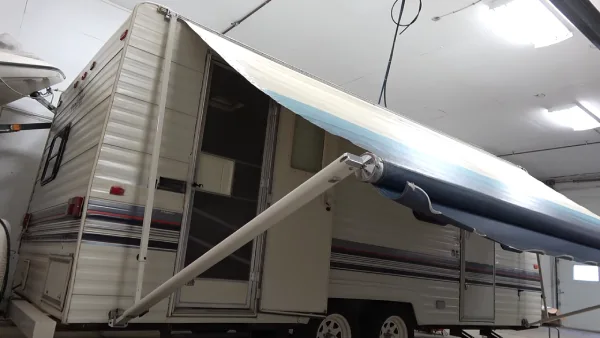
An RV awning’s life expectancy can vary based on various factors, such as the quality of the awning, maintenance, and environmental conditions.
Generally, a well-maintained RV awning can last anywhere between 5 to 15 years. This estimate underscores the importance of proper care, cleaning, and storage of the awning to extend its lifespan.
Environmental conditions like severe weather can also be vital to the awning’s longevity. So, regular inspections of the awning for potential damages and repairs can help increase its lifespan.
To estimate the replacement needs of an RV awning, it is essential to consider its quality, maintenance routine, and exposure to environmental factors.
How long does it take to replace an RV awning?
Replacing an RV awning can typically take a few hours to half a day, depending on the complexity of the installation and the experience level of the person doing the replacement.
If you’re familiar with DIY projects and have some basic tools, you may be able to replace a standard RV awning in about 2-4 hours.
This would involve removing the old awning, measuring and ordering the new one, and then installing the new awning onto the RV. However, it could take longer if you’re new to DIY or any additional modifications or repairs are needed.
Invest in Quality RV Awning Replacement for Comfort and Safety
Replacing an RV awning can be costly, but it is necessary to ensure the comfort and safety of your RV trips. Before deciding, it is important to consider the material, size, and type of awning that best fits your needs and budget.
While DIY replacement may seem like a cost-effective option, it is important to weigh the risks and potential additional expenses that may arise.
Hiring a professional company for replacement guarantees quality workmanship and reduces the likelihood of mistakes or accidents.
You can cut RV awning replacement costs by shopping around for deals and discounts can be helpful. Also, reusing parts from the old awning can also reduce expenses.
Ultimately, investing in an RV awning replacement may seem daunting at first, but with careful consideration and research, it is possible to find affordable options without sacrificing quality.

